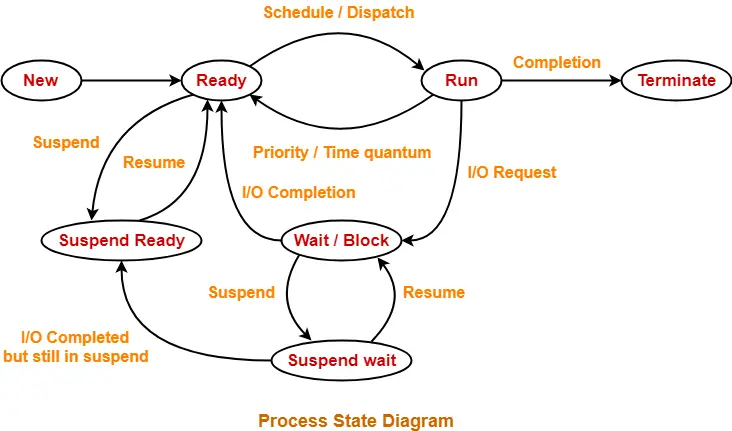Process States in Operating System-
Each process goes through different states in its life cycle-

1. New State-
- A process is said to be in new state when a program present in the secondary memory is initiated for execution.
2. Ready State-
- A process moves from new state to ready state after it is loaded into the main memory and is ready for execution.
- In ready state, the process waits for its execution by the processor.
- In multiprogramming environment, many processes may be present in the ready state.
3. Run State-
- A process moves from ready state to run state after it is assigned the CPU for execution.
4. Terminate State-
- A process moves from run state to terminate state after its execution is completed.
- After entering the terminate state, context (PCB) of the process is deleted by the operating system.
5. Block Or Wait State-
- A process moves from run state to block or wait state if it requires an I/O operation or some blocked resource during its execution.
- After the I/O operation gets completed or resource becomes available, the process moves to the ready state.
6. Suspend Ready State-
- A process moves from ready state to suspend ready state if a process with higher priority has to be executed but the main memory is full.
- Moving a process with lower priority from ready state to suspend ready state creates a room for higher priority process in the ready state.
- The process remains in the suspend ready state until the main memory becomes available.
- When main memory becomes available, the process is brought back to the ready state.
6. Suspend Wait State-
- A process moves from wait state to suspend wait state if a process with higher priority has to be executed but the main memory is full.
- Moving a process with lower priority from wait state to suspend wait state creates a room for higher priority process in the ready state.
- After the resource becomes available, the process is moved to the suspend ready state.
- After main memory becomes available, the process is moved to the ready state.
Important Notes-
Note-01:
| A process necessarily goes through minimum 4 states. |
- The minimum number of states through which a process compulsorily goes through is 4.
- These states are new state, ready state, run state and terminate state.
- However, if a process also requires the I/O operation, then minimum number of states is 5.
Note-02:
| A single processor can execute only one process at a time. |
- A single processor can not more than one processes simultaneously.
- If n processors are present in the system, then only n processes can be executed simultaneously.
Note-03:
| State | Present in Memory |
| New state | Secondary Memory |
| Ready state | Main Memory |
| Run state | Main Memory |
| Wait state | Main Memory |
| Suspend wait state | Secondary Memory |
| Suspend ready state | Secondary Memory |
| Terminate state | – |
Note-04:
| Moving a process from wait state to suspend wait state is a better alternative. |
- Consider a process with higher priority arrives and the main memory is full.
- Then, there are two ways to make room for it.
These two ways are-
- Moving a process with lower priority from ready state to suspend ready state.
- Moving a process with lower priority from wait state to suspend wait state.
Out of these-
- Moving a process from wait state to suspend wait state is a better alternative.
- This is because the process is already waiting for some blocked resource.
To gain better understanding about Process States in Operating System,
Next Article- Process Control Block | PCB
Get more notes and other study material of Operating System.
Watch video lectures by visiting our YouTube channel LearnVidFun.